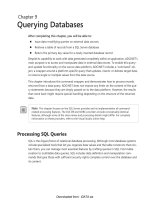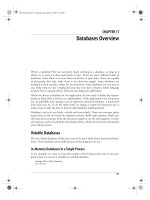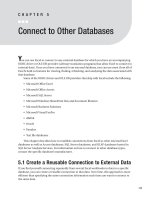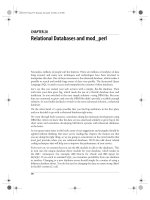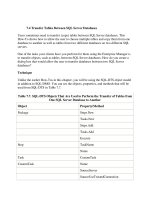Databases
Bạn đang xem bản rút gọn của tài liệu. Xem và tải ngay bản đầy đủ của tài liệu tại đây (507.67 KB, 46 trang )
Databases
D
atabases have traditionally been treated as entities distinct from the larger code base. This
is reflected organizationally; a firm wall often exists between developers and database admin-
istrators (DBAs); the DBAs work in parallel with the rest of the organization.
This is rooted in the historical nature of the technology. In the past, databases have been
expensive both in terms of software and hardware, and this means that there haven’t been
very many of them. With so few resources, very few people acquired the skills to work with
them. Dedicated staff were required to gate access to these limited resources, and to prevent
the naive from doing stupid things. Additionally, most products were very hard to configure.
Getting acceptable performance required much tuning, and thus even more expertise. The
company jewels were often stored in these mines, and had to be protected from fumbling
hands and untested scripts.
In recent years, the technical landscape has changed. Over the last ten years, free data-
base implementations have blossomed, as have computing and storage capabilities.
This has given rise to a proliferation of databases. SQL databases have morphed from
beasts with complicated interacting processes and dedicated raw filesystem drivers to server-
less libraries that can be linked and embedded within shipping code. Examples of these
include HSQLDB, embedded MySQL, and SQLite. As of Python 2.5, SQLite even ships in the
standard library.
Every developer can now have a database on the desktop (or laptop or palmtop). The con-
sequences of this have been slow to sink in. Agile software development techniques have a
long history behind them, but agile database development techniques do not.
A New Religion
The ultimate goal of any development organization is delivering business value. While the
proximate goal of development is producing software and the proximate goal of a database is
organizing data for retrieval, these are not the ultimate organizational goals. If the CEO could
get the same information more cheaply and reliably by calling a televangelist, then she’d be
doing it.
263
CHAPTER 9
9810ch09.qxd 6/4/08 9:47 AM Page 263
Neither the goals of development nor the goals of the DBA organization are meaningful
w
ithout assistance from the each other. Development wants to use the databases to accom-
plish meaningful work for the company, and the DBAs want to ensure that the company’s data
is protected.
1
These two organizations are often at loggerheads when they should be working
in concert to meet the overall organization’s needs.
Agile development recognizes that different business groups have differing needs and pri-
orities, and that these change over time. Code must change to reflect these realities, and this
leads to the need for constant refactoring. The same is true of data models. Like Code, they
will rot if they're not regularly maintained.
The database groups need to work closely with their customers to understand these
issues. As with development, they need to focus on the issues with the biggest payoffs. The
work should be prioritized, and some things will fall by the wayside. There will always be new
problems, so the database organization shouldn’t try to solve everything. The key is not to try
to eliminate and address all problems, but to design a process that addresses new issues as
normal occurrences.
Blurring the Boundaries
Only by creating integrated and fully automated processes can an organization meet the rapid
turnaround required by short iterations, and this can only be done by integrating the automa-
tion into the entire production cycle from start to finish. Agile development breaks down
some of the separations between development, operation, and administration. Agile develop-
ment therefore has strong impacts on the DBA organization:
Database design becomes an
evolutionary process. Since change is a constant pressure,
the database schema is never complete. These changes must be propagated quickly from
development through to production. This must be done in such a way that it can be repli-
cated, and it must be done without human intervention.
Databases are improved through
refactorings. These are changes that improve the struc-
ture of the database without altering its function. The need to accommodate live changes
imposes certain design constraints not present in code.
Code must be
isolated from the underlying data model as much as possible. Much is writ-
ten about an object-relational mismatch. I don’t subscribe to that view any more than I
subscribe to a view of an object-filesystem mismatch or an object-thread mismatch.
Relational databases are complicated, but that doesn’t mean that there is a fundamental
misfit. It does mean that there is a lot of machinery required to magically unify the two.
T
esting
must be perfor
med. Changes
must be made to the database
. Changes must also
be made to the code that uses the database. A variety of techniques are used to accom-
plish these tests
. S
ome require little more than the machinery already discussed in
previous chapters
, and some r
equir
e new classes of softwar
e
.
CHAPTER 9
■
DATABASES264
1. The DBAs should ensure that the company’s data is available and protect it from loss. Often the first is
for
gotten, but if nobody is doing useful wor
k with the production databases, then either the databases
are superfluous or the company is in dire trouble. Either way, the DBAs are in trouble.
9810ch09.qxd 6/4/08 9:47 AM Page 264
Developers and DBAs both have a role in this, but since many tools reside in the software
d
evelopment process, the DBAs have to learn more about those tools and processes. At the
same time, developers will have to learn more about being a DBA. The DBA’s job becomes less
about adjudicating changes and more about providing expertise and advising against absolute
stupidity. Because there is no clear organizational boundary, the DBAs have to work closely
with the developers to ensure that proper procedural boundaries are observed.
Concealing Data Access
At some point, your code has to talk to the database. At that point, the code needs to under-
stand the details of the data. It must know how to locate the data source and initiate a
conversation. It must know the structure of the data to perform efficient queries. It needs to
convert between local types and stored types, and back again, and it must know how and
when to write out changes. It must be able to recognize stale results, and it often needs to
cache data that is expensive to retrieve from the database.
When the structure of the data changes, the code that accesses that data needs to change.
If the data access code is scattered throughout a program, then every change necessitates
seeking those points out and rewriting the access code. This is time-consuming and prone to
error.
Therefore, code dealing with the database should be in a central location. This layer
mediates all access to the database. It can be as simple or as complex as needed. At one end
of the spectrum, it might simply be a few methods that read and write strings to a file. At the
other end are systems that map between relational databases and classes or objects within a
program.
Such libraries are called object-relational mappers (ORMs). These subsystems provide an
elaborate framework concealing the details of the underlying query mechanisms. They make
it easy to interface with the underlying database systems. With a good ORM, it is easier to
write database access code than it is to work with files.
Object-Relational Mappers
ORMs generally have four aspects:
• A description of the database schema
• A mapping between the schema and the application objects
•
A way of selecting data
• A mechanism for writing changes
ORMs differ widely in how these are aspects are handled. In some cases, they are manu-
ally specified. In others, they are automatically derived from a running system. In some cases,
the running system’s configuration is derived from the ORM definitions.
I’m going to discuss the two leading Python ORMs: SQLObject and SQLAlchemy. There
are three common patterns that are useful when discussing them:
CHAPTER 9
■
DATABASES 265
9810ch09.qxd 6/4/08 9:47 AM Page 265
• Active record
• Data mapper
•
Unit of work
The Active Record Pattern
The active record pattern describes a simple relationship between a database and the pro-
gramming language. A database table corresponds to a class, a row in a table corresponds to
an instance of the class, and a column corresponds to an attribute.
Queries return objects, and the values are read from the attributes. Writing to an attribute
updates the database. Creating an instance inserts a row. Deleting an object deletes the row.
Inherent in the active record pattern is the idea that each row has an identity.
This pattern is easy to describe and understand. It combines the steps of describing the
database schema and producing a mapping between the schema and application objects. It
has the advantage of working very well for small-to-medium-sized cases.
While it easily maps tables, rows, and columns, it doesn’t easily map other database
objects, such as procedure results, views, joins, column selects, and multitable or multidata-
base results.
The biggest problem with the active record pattern is that the resulting code closely
mirrors the database schema. When the database structure changes, the code must also
change, and these changes are distributed throughout the code. Solving this requires a layer
of indirection.
The Data Mapper Pattern
The data mapper pattern maps columns into arbitrary objects. The underlying structure is
described, and then the mappings are specified between the storage entities and the applica-
tion objects.
This indirection separates the database from the application. The storage format can be
altered, while the objects remain the same, and vice versa. Changing the database structure
no longer necessitates changing the application code, and arbitrary SQL results can be sensi-
bly mapped.
On the other hand, it’s a little more complicated to set up. It hides database access and
structure by distributing them throughout your code. The relationships between attributes in
one place and those in another can be concealed. I
t
’
s a little harder to understand what is
going on in some cases.
The Unit of Work Pattern
I
n this pattern, the
code tracks the changes that have been made and commits them in a
single batch within a single transaction.
Talking to the database is expensive. Each batch of changes incurs a significant time lag.
Often the major
ity of an application
’
s time is spent waiting for results from the database. I
have personally seen situations in which more than 90 percent of an application’s response
time was spent waiting on the database. The actual code took microseconds to run, but each
CHAPTER 9
■
DATABASES266
9810ch09.qxd 6/4/08 9:47 AM Page 266
round trip to the database took milliseconds. Committing the changes in a single batch
r
educes this overhead dramatically.
Since the database transaction is only held for the length of the batched connection, there
is less contention between queries and less opportunity for deadlock. The application quickly
uses and returns connections, so the running application needs to have fewer open connec-
tions to the database in order to achieve the same throughput.
The application is in control of the commits, so it knows when problems occur. The com-
mit points also provide a natural point to handle rollback.
There are disadvantages, though. Control comes at the expense of effort and forethought.
Developers must be aware of when changes are committed and how the batches are con-
structed. Potentially, an application can continue running with uncommitted changes that
haven’t been rolled back, leading to inconsistent views of the database and possible loss of
data. The application may be less responsive. While its overall performance may increase, the
lower latency of a do-it-immediately approach may be worth the increase in responsiveness.
A straight do-it-now access policy is useful and appropriate for many small applications.
Python ORMs
There are many Python ORMs, but there are two 900-pound gorillas. They are SQLObject and
SQLAlchemy. SQLObject has been around quite a bit longer than SQLAlchemy, but the latter is
gaining in popularity. Although more complicated for novices, it is far more capable when it
comes to real production problems.
SQLObject
SQLObject is based on the active record pattern. It has minimal support for the unit of work
pattern, and many people simply write to the database. It has an aggressive caching policy by
default, and it uses a simple declarative format to specify both the schema and mappings. It
really wants to use numeric keys for database records.
As always, obtaining the package is the first step:
$ easy_install -U SQLObject
Searching for SQLObject
Reading />...
Processing dependencies for SQLObject
Finished processing dependencies for SQLObject
I’
m using a classic example—that of students in a school. The
student table looks like
Figure 9-1.
CHAPTER 9
■
DATABASES 267
9810ch09.qxd 6/4/08 9:47 AM Page 267
Figure 9-1. The student table
The schema for this table might be generated by the following SQL:
CREATE TABLE student (
ID INTEGER PRIMARY KEY AUTOINCREMENT,
full_name VARCHAR(64) NOT NULL,
username VARCHAR(16) NOT NULL
);
This table would be described to SQLObject as follows:
from sqlobject import SQLObject, StringCol
class Student(SQLObject):
username = StringCol(length=16)
fullName = StringCol(length=64)
Connecting to the Database
The next step is establishing a connection to the database. SQLObject uses standard connec-
tion URI syntax:
scheme://[user[:password]@]host[:port]/database[?parameters]
Examples include the following:
•
mysql://jeff:myPasswordHere@localhost/test_db
• postgres:///another_db?debug=1&cache=0
• postges:///path/to/socket/db_name
• sqlite:///path/to/the/database
As of version 0.9, the common parameters are as follows:
•
debug
• debugOutput
• debugThreading
• cache
CHAPTER 9
■
DATABASES268
9810ch09.qxd 6/4/08 9:47 AM Page 268
• autoCommit
• l
ogger
• l
ogLevel
Since SQLite ships with Python, I’ll be using it for the examples. The following code frag-
ment sets up a SQLite connection:
filename = "test_db"
abs_path = os.path.abspath(filename)
connection_uri = 'sqlite://' + abs_path
connection = sqlobject.connectionForURI(connection_uri)
sqlobject.sqlhub.processConnection = connection
You can turn this into the following method:
def sqlite_connect(abs_path):
connection_uri = 'sqlite://' + abs_path
connection = sqlobject.connectionForURI(connection_uri)
sqlobject.sqlhub.processConnection = connection
The important thing is that you set the processConnection variable to the correct connec-
tion. If you turn this into a method, the corresponding test is as follows:
@use_pymock
def test_sqlite_connect():
f = '/x'
uri = 'sqlite:///x'
connection = dummy()
override(sqlobject, 'connectionForURI').expects(uri).\
returns(connection)
replay()
sqlite_connect(f)
assert sqlobject.sqlhub.processConnection is connection
verify()
Creating Rows
New rows are created by instantiating objects. Here’s a simple test for this:
s1 = Student(username="jeff", fullName="Jeff Younker")
assert s1.username == "jeff"
assert s1.fullName == "Jeff Younker"
There’s a good deal of setup and tear-down that needs to be done, though. A new data-
base file must be created, and the connection to that database must be initiated. At the end of
the test, the file should be removed, the object cache should be cleared to prevent other tests
from stomping on yours, and finally the connection should be closed.
CHAPTER 9
■
DATABASES 269
9810ch09.qxd 6/4/08 9:47 AM Page 269
■
Note
The connection hub’s caching plays havoc with the SQLite driver, so the test generates a new ran-
domly named connection each time.
import random
...
def random_string(length):
seq = [chr(x) for x in range(ord('a'), ord('z')+1)]
return ''.join([x for x in random.sample(seq, length)])
def test_creating_student():
f = os.path.abspath(random_string(8) + '.db')
if os.path.exists(f):
os.unlink(f)
sqlite_connect(f)
try:
s1 = Student(username="jeff", fullName="Jeff Younker")
assert s1.username == "jeff"
assert s1.fullName == "Jeff Younker"
finally:
sqlobject.sqlhub.processConnection.cache.clear()
sqlobject.sqlhub.processConnection.close()
del sqlobject.sqlhub.processConnection
os.unlink(f)
When this runs, it gives the following error:
Traceback (most recent call last):
File "/Library/Python/2.5/site-packages/nose-0.10.0-py2.5.egg/nose/case.py",
➥
line 202, in runTest
self.test(*self.arg)
...
File "/Users/jeff/Library/Python/2.5/site-packages/SQLObject-0.10.0b2-py2.5.egg/
➥
sqlobject/sqlite/sqliteconnection.py", line 177, in _executeRetry
raise OperationalError(ErrorMessage(e))
OperationalError: no such table: student
I
n other wor
ds
, the schema has not been defined yet. The tests could create the schema
directly, but that ties them to the specific database used for the unit tests. Fortunately,
SQLObject instances know how to create themselves. One command creates this new table.
The r
evised test method is as follo
ws:
def test_creating_student():
f = os.path.abspath('test_db')
if os.path.exists(f):
os.unlink(f)
CHAPTER 9
■
DATABASES270
9810ch09.qxd 6/4/08 9:47 AM Page 270
sqlite_connect(f)
try:
Student.createTable()
s1 = Student(username="jeff", fullName="Jeff Younker")
assert s1.username == "jeff"
assert s1.fullName == "Jeff Younker"
finally:
sqlobject.sqlhub.processConnection.cache.clear()
sqlobject.sqlhub.processConnection.close()
del sqlobject.sqlhub.processConnection
os.unlink(f)
The test now runs successfully to conclusion. It’s a mess, though, and there are going to
be many more of these written. The setup and tear-down can be refactored into a decorator:
from decorator import decorator
...
@decorator
def with_sqlobject(tst):
f = os.path.abspath(random_string(8) + '.db')
if os.path.exists(f):
os.unlink(f)
sqlite_connect(f)
try:
Student.createTable()
tst()
finally:
sqlobject.sqlhub.processConnection.cache.clear()
sqlobject.sqlhub.processConnection.close()
os.unlink(f)
@with_sqlobject
def test_writing_student():
s1 = Student(username="jeff", fullName="Jeff Younker")
assert s1.username == "jeff"
assert s1.fullName == "Jeff Younker"
The resulting test is significantly more concise. The preceding code uses the decorator
module, which is a third-party module that simplifies writing decorators. Most decorators
usually involv
e cr
eating at least one closur
e, and this closure is nearly always the same. Here’s
a decorator that prints
before and then executes the wrapped function:
def before(f):
def wrapper(*args, *kw):
print "before"
return f(*args, **kw)
return wrapper
CHAPTER 9
■
DATABASES 271
9810ch09.qxd 6/4/08 9:47 AM Page 271
The decorator module supplies the necessary closure machinery:
from decorator import decorator
...
@decorator
def before(f, *args, **kw)
print "before"
return f(*args, **kw)
I find the resulting decorators much cleaner and easier to understand.
Putting the Schema Where It Belongs
Right now there is only one table, but eventually there will be many. Every time a new table is
added, the schema definition in
with_sqlobject() will grow. This schema creation informa-
tion may also be useful in the program itself, particularly when it needs to be installed, so it
should go into the file with the schema declarations.
from sqlobject_ex import create_schema
...
@decorator
def with_sqlobject(tst):
f = os.path.abspath(random_string(8) + '.db')
if os.path.exists(f):
os.unlink(f)
sqlite_connect(f)
try:
create_schema()
tst()
finally:
sqlobject.sqlhub.processConnection.cache.clear()
sqlobject.sqlhub.processConnection.close()
os.unlink(f)
And the create_schema() method should go into sqlobject_ex.py:
def create_schema():
Student.createTable()
Attribute Defaults
What
happens if one of the student attributes is omitted? For example
>>> Student(fullName="Jeff Younker")
gives the following error:
CHAPTER 9
■
DATABASES272
9810ch09.qxd 6/4/08 9:47 AM Page 272
Traceback (most recent call last):
...
ValueError: Unknown SQL builtin type: <type 'classobj'> for <class sqlobject.sql
➥
builder.NoDefault at 0xde05d0>
All attributes are required unless a default is defined. In other words, all attributes are
assumed to be
NOT NULL unless declared otherwise with the default attribute. The following
code makes the username optional:
class Student(SQLObject):
username = StringCol(length=16, default=None)
fullName = StringCol(length=64)
Selecting Objects
SQLObject has three methods for retrieving objects from the database. The get() method
retrieves a single object by its ID. The attribute
id maps to the field ID. It is transparently man-
aged by the ORM. All mapped tables must have an ID field.
@with_sqlobject
def test_get():
s1 = Student(username="jeff", fullName="Jeff Younker")
s2 = Student.get(s1.id)
assert s1 is s2
The select() class method chooses one or more objects. With no arguments, it returns all
instances in the table.
from sets import Set
...
@with_sqlobject
def test_select():
s1 = Student(username="jeff", fullName="Jeff Younker")
s2 = Student(username="doug", fullName="Doug McBride")
students = list(Student.select())
assert len(students) == 2
assert Set(students) == Set([s1, s2])
The select() method takes a SQLB
uilder expr
ession.
SQLB
uilder is part of SQL
Object.
You build SQL queries from SQLBuilder calls. The package makes extensive use of operator
o
v
erloading, so for simple cases, queries look just like normal Python comparison expressions.
@with_sqlobject
def test_select_using_full_name():
s1 = Student(username="jeff", fullName="Jeff Younker")
unused_s2 = Student(username="doug", fullName="Doug McBride")
students = Student.select(Student.q.fullName == "Jeff Younker")
assert list(students) == [s1]
CHAPTER 9
■
DATABASES 273
9810ch09.qxd 6/4/08 9:47 AM Page 273
The class variable Student.q contains column descriptions. These are used in SQLBuilder
queries. The preceding expression translates to the following SQL:
select * from student where full_name = "Jeff Younker"
For simple comparisons, you’ll never have to access SQLBuilder directly, but more eso-
teric expressions require more direct meddling. The following code uses a SQL-like expression
to search for all students with a full name containing
ou.
from sqlobject.sqlbuilder import LIKE
...
@with_sqlobject
def test_select_using_partial_name():
s1 = Student(username="jeff", fullName="Jeff Younker")
s2 = Student(username="doug", fullName="Doug McBride")
unused_s3 = Student(username="amy", fullName="Amy Woodward")
students = Student.select(LIKE(Student.q.fullName, '%ou%'))
assert Set(students) == Set([s1, s2])
The selectBy() method is a concise method of querying exact column matches. Key-
words specify the attributes to be compared, and the values are those to be compared with.
@with_sqlobject
def test_selectBy_full_name():
s1 = Student(username="jeff", fullName="Jeff Younker")
unused_s3 = Student(username="amy", fullName="Amy Woodward")
students = Student.selectBy(fullName="Jeff Younker")
assert list(students) == [s1]
Like select(), if no arguments are supplied, it returns the entire table:
@with_sqlobject
def test_selectBy_all():
s1 = Student(username="jeff", fullName="Jeff Younker")
s2 = Student(username="doug", fullName="Doug McBride")
students = Student.selectBy()
assert Set(students) == Set([s1, s2])
Updating Fields
Values are modified via simple assignment:
@with_sqlobject
def test_modify_values():
s1 = Student(username="jeff", fullName="Jeff Younker")
s1.fullName = "Jeff M. Younker"
students = Student.selectBy(fullName="Jeff M. Younker")
assert list(students) == [s1]
CHAPTER 9
■
DATABASES274
9810ch09.qxd 6/4/08 9:47 AM Page 274
Deleting Rows
All SQLObject instances have a destroySelf() method. Calling this method deletes the associ-
a
ted row from the database:
@with_sqlobject
def test_delete():
s1 = Student(username="jeff", fullName="Jeff Younker")
s1.destroySelf()
students = Student.select()
assert list(students) == []
The destroySelf() method does not perform cascading deletes, but that can be accom-
plished by overriding this method.
One-to-Many Relationships
SQLObject specifies joins (specifically inner joins) declaratively. The products of the joins
appear as arrays contained in instance variables. To demonstrate, I’ve expanded the schema
to include an e-mail address for each student. Each student may have more than one e-mail
address (see Figure 9-2).
Figure 9-2. A many-to-one relationship between student and e-mail address
The corresponding SQL for the new table is as follows:
CREATE TABLE email (
ID INTEGER PRIMARY KEY AUTOINCREMENT,
address VARCHAR(255) NOT NULL,
studentID INTEGER NOT NULL,
FOREIGN KEY studentID REFERENCES student(id)
);
Foreign Keys
The new table is defined in sqlobject_ex.py as follows:
from sqlobject import ForeignKey, SQLObject, StringCol
...
class Email(SQLObject):
email = StringCol(length=255)
CHAPTER 9
■
DATABASES 275
9810ch09.qxd 6/4/08 9:47 AM Page 275
student = ForeignKey('Student')
...
def create_schema():
Student.createTable()
Email.createTable()
ForeignKey
defines the attribute student as a link to the class Student. When this attribute
is accessed, the key
studentID will be dereferenced and the row will be instantiated. The IDs
are handled under the hood.
@with_sqlobject
def test_email_creation():
s1 = Student(username="jeff", fullName="Jeff Younker")
s2 = Student(username="doug", fullName="Doug McBride")
e1 = Email(address="", student=s1)
assert e1.student is s1
e1.student = s2
assert e1.student is s2
SQLObject foreign keys are always expected to end in ID. This is one of the drawbacks of
using SQLObject. The underlying foreign key can be accessed directly via the attribute:
@with_sqlobject
def test_direct_id_access():
s1 = Student(username="jeff", fullName="Jeff Younker")
s2 = Student(username="doug", fullName="Doug McBride")
e1 = Email(address="", student=s1)
assert e1.studentID == s1.id
e1.studentID = s2.id
assert e1.student is s2
Multiple Joins
So far, if the code has an Email, it can locate the associated Student, but there is no way to go
in the other direction.
The
MultipleJoin class pro
vides this functionality.
You modify the
Student class like this:
from sqlobject import ForeignKey, MultipleJoin, SQLObject, StringCol
...
class
Student(SQLObject):
fullName = StringCol(length=64)
username = StringCol(length=16)
emails = MultipleJoin('Email')
Accessing the emails attribute returns a list of associated Email objects:
CHAPTER 9
■
DATABASES276
9810ch09.qxd 6/4/08 9:47 AM Page 276
@with_sqlobject
def
test_multiple_join():
s1 = Student(username="jeff", fullName="Jeff Younker")
e1 = Email(address="", student=s1)
assert s1.emails == [e1]
If there are no objects, then an empty list is returned:
@with_sqlobject
def
test_multiple_join_empty_returns_empty_list():
s1 = Student(username="jeff", fullName="Jeff Younker")
assert s1.emails == []
The attribute looks like it should be mutable, but you can't assign to it:
@with_sqlobject
def
test_multiple_join_cant_assign():
s1 = Student(username="jeff", fullName="Jeff Younker")
e1 = Email(address="", student=s1)
try:
s1.emails = [e1]
assert False
except AttributeError:
pass
MultipleJoin
attributes are read-only. The only way to alter their contents is by changing
the foreign key:
@with_sqlobject
def
test_changing_a_multiple_join():
s1 = Student(username="jeff", fullName="Jeff Younker")
s2 = Student(username="doug", fullName="Doug McBride")
e1 = Email(address="", student=s1)
e2 = Email(address="", student=s2)
assert s1.emails == [e1]
e2.student = s1
assert Set(s1.emails) == Set([e1, e2])
Many-to-Many Relationships
S
tudents ar
e in
many classes
, and classes contain many students. This kind of relationship is
referred to as a many-to-many relationship. In relational databases, these are expressed
through intermediate tables. Each entry is essentially a double-ended pointer to the tables it
r
elates (see F
igur
e 9-3).
CHAPTER 9
■
DATABASES 277
9810ch09.qxd 6/4/08 9:47 AM Page 277
Figure 9-3. A many-to-many relationship between students and classes
The SQL defining these tables in SQLite is as follows:
CREATE TABLE course (
ID INTEGER PRIMARY KEY AUTOINCREMENT,
name VARCHAR(64) NOT NULL
);
CREATE TABLE student_course_assc (
studentID INTEGER NOT NULL,
courseID INTEGER NOT NULL,
FOREIGN KEY studentID REFERENCES student(ID),
FOREIGN KEY courseID REFERENCES course(ID)
);
Only the target class is defined. The intermediate table is implicit in the RelatedJoin dec-
larations. The components related to the join are shown in bold:
from sqlobject import ForeignKey, MultipleJoin, RelatedJoin, \
SQLObject, RelatedJoin, StringCol
...
def create_schema():
Student.createTable()
Email.createTable()
Course.createTable()
...
CHAPTER 9
■
DATABASES278
9810ch09.qxd 6/4/08 9:47 AM Page 278
class Student(SQLObject):
fullName = StringCol(length=64)
username = StringCol(length=16)
emails = MultipleJoin('Email')
courses = RelatedJoin('Course')
...
class Course(SQLObject):
name = StringCol(length=64)
students = RelatedJoin('Student')
Joining Students and Courses
The join statements create add and remove methods. These are named after the class being
joined. In the
Student class, they would be addCourse() and removeCourse(). As with a multi-
ple join, the attribute returns a list of associated objects:
from sqlobject_ex import Course, Email, sqlite_connect, Student, create_schema
...
@with_sqlobject
def test_related_join_add():
s1 = Student(username="jeff", fullName="Jeff Younker")
c1 = Course(name="Modern Algebra")
c2 = Course(name="Biochemistry")
s1.addCourse(c1)
s1.addCourse(c2)
assert Set(s1.courses) == Set([c1, c2])
assert c1.students == [s1]
assert c2.students == [s1]
The relationship can be established from either end:
@with_sqlobject
def test_related_join_add_in_other_order():
s1 = Student(username="jeff", fullName="Jeff Younker")
c1 = Course(name="Modern Algebra")
c2 = Course(name="Biochemistry")
s1.addCourse(c1)
c2.addStudent(s1)
assert Set(s1.courses) == Set([c1, c2])
assert c1.students == [s1]
assert c2.students == [s1]
Relations are removed with the removeFoo() method:
CHAPTER 9
■
DATABASES 279
9810ch09.qxd 6/4/08 9:47 AM Page 279
@with_sqlobject
def test_related_join_remove():
s1 = Student(username="jeff", fullName="Jeff Younker")
c1 = Course(name="Modern Algebra")
c2 = Course(name="Biochemistry")
s1.addCourse(c1)
s1.addCourse(c2)
assert Set(s1.courses) == Set([c1, c2])
c2.removeStudent(s1)
s1.removeCourse(c1)
assert s1.courses == []
assert c1.students == [] and c2.students == []
Adds can be performed multiple times, and they result in multiple records:
@with_sqlobject
def test_related_join_multiple_adds():
s1 = Student(username="jeff", fullName="Jeff Younker")
c1 = Course(name="Modern Algebra")
s1.addCourse(c1)
s1.addCourse(c1)
assert s1.courses == [c1, c1]
assert c1.students == [s1, s1]
Removes take away all the duplicates:
@with_sqlobject
def test_related_join_removing_multiples():
s1 = Student(username="jeff", fullName="Jeff Younker")
c1 = Course(name="Modern Algebra")
s1.addCourse(c1)
s1.addCourse(c1)
s1.removeCourse(c1)
assert s1.courses == []
Multiple Relationships
M
ultiple relationships are frequently created between two tables. For example, a student may
be enrolled in a course or have completed a course. A corresponding schema is shown in
Figure 9-4.
CHAPTER 9
■
DATABASES280
9810ch09.qxd 6/4/08 9:47 AM Page 280
